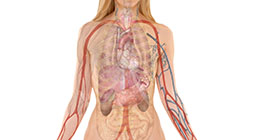
Overview
Symptoms
Diagnosis
Causes
Prescription
Health Tips
Endometriosis affects approximately one in ten women of childbearing age worldwide. It can start with a girl’s first period and may continue to affect some women throughout their lives until menopause. Endometriosis is one of the most common and misunderstood of female diseases.
In women with endometriosis, tissue that is very similar to that of the uterine lining (endometrium) grows in other parts of the body. While commonly found on the outside of the uterus, ovaries, fallopian tubes, pelvic ligaments or bowel, it may also affect the bladder, cervix, or vagina, or even travel as far as the lungs. Women are often misdiagnosed with irritable bowel syndrome, bladder infections, appendix attacks, “just” PMS, or painful cramps.
The Endometriosis Association states that it is extremely rare for a woman today to need a hysterectomy for endometriosis, no matter how severe. Yet many doctors do not follow these guidelines.
Full hysterectomies do not cure endometriosis. While a hysterectomy may help with pain, in about 15 percent of women relief is only temporary.
Symptoms
While some women may not experience any symptoms, for others it can be devastatingly painful and debilitating, beginning with the onset of menstruation and increasing progressively until menopause.
Warning symptoms of endometriosis:
- Bladder infection suspected, but test results are negative
- Heavy periods
- History of ovarian cysts
- Infertility of unknown origin; 30 to 40 percent of women experiencing infertility have endometriosis
- Intermenstrual pain, usually at mid-month
- Menstrual cramps that increase in severity
- Painful bowel movements and urination
- Painful intercourse (dyspareunia)
- Pelvic pain that is all-encompassing
- Spotting between periods
Some women experience no pain but may have fertility, ovarian or menstrual problems. The symptoms are many and vary from woman to woman.
Careful Diagnosis
Endometriosis can be difficult to diagnose. Pelvic examinations by a highly skilled gynecologist may disclose nodules or lesions on the ovaries. Ultrasound tests will only show endometriosis if the ovaries are involved. Laparoscopy is the only diagnostic technique that can clearly determine if endometriosis is present. This examination, performed under general anesthetic, involves inserting a light containing telescope through a small incision in the navel. Another one or two small incisions along the bikini line are made for the instruments.
A laparoscopy is only as good as the surgeon who performs the exam. Removing all the endometriotic tissue requires a physician who is committed to biopsy and getting rid of all suspicious abnormalities. The surgeon needs to be meticulous to clear endometriosis in one surgery.
Endometrial tissue can look like tiny blueberries or black spots, or white, yellow or reddish cysts, varying from tiny bluish or dark brown blisters to large chocolate-coloured cysts up to 20 centimeters in diameter. Only a biopsy can confirm which tissue is truly endometriotic.
Causes
Until recently, the predominant theory to explain the cause of endometriosis was retrograde menstrual flow. It was believed that blood flowing backwards would push tiny fragments of normal endometrial tissue (from the lining of the uterus) up the fallopian tubes which then would adhere to the abdominal or pelvic cavity. Once there this tissue acts as it would in the uterus in accordance with the monthly menstrual cycle. However, the blood often cannot escape and causes the formation of deposits and severe pain.
Research continues exploring genetic abnormalities and heredity as potential factors in the condition. For example, if a woman’s sister or mother had the disease then she is also a prime candidate to develop endometriosis.
Endometriosis is worsened by estrogen replacement therapy, and estrogen dominance can worsen symptoms.
Although rare, secondary endometriosis may occur, which is when endometrial tissue grows at the site of an incision after surgery on the uterus, such as a caesarean section.
The Immune System
Other researchers believe that retrograde menstruation occurs, but it is only in those women with altered immune function that the endometrial tissue implants in other body areas. Not all women who experience retrograde menstruation will have endometriosis. The immune system should not allow the endometrial tissue to survive where it does not belong. Once this abnormal tissue is present, the immune system may mount an antibody response and create inflammation and pain in the region involved.
New research points to a glitch in the immune system. Dr. David Redwine, world-renowned expert and former director of the Endometriosis Program at St. Charles Medical Center in Bend, Oregon, believes that some women are born with abnormally located endometrial cells and that something goes awry with the immune system, and as a result the cells become active. This theory has earned acceptance because endometrial tissue cells have been found in the nose, lungs, and other organs far from the uterus.
Environmental Pollutants
Links between organochlorine exposure and the development of endometriosis have been made. Organochlorines are persistent, toxic substances, like DDT, PCP and dioxins. They are estrogen mimickers, causing an increase in estrogens in the body. Endometriosis is thought to be more common in women who have higher than normal circulating estrogens. Organochlorines are used in PVC plastics (drinking water runs through pipes made from PVC in most homes), solvents, pesticides, refrigerants, and in the pulp and paper industry. These same chemicals also persist in the fats of meat and dairy products. The Environmental Protection Agency estimates that 90 percent of human dioxin exposure is through food, primarily meat and dairy products.
Prescription for Health
Surgery to remove the majority of the endometriosis lesions, along with the following nutrient recommendations, examining and reducing stress levels, and avoiding exposure to environmental toxins will all help to put endometriosis into enduring remission. Many women have been able to eliminate endometriosis permanently.
Pain Relief
Castor oil packs are excellent at controlling pain. Take six pieces of flannel soaked in castor oil (damp but not dripping) about the size of the area to treat. Cover these flannel pieces with a hot water bottle wrapped in a towel and place on the lower abdomen for 30 to 45 minutes, several times a day. This not only relieves pain but also improves circulation in the pelvic area.
Diet
Anti-inflammatory foods may help to ease symptoms of endometriosis.
Foods to include: (reduce inflammation in the body)
- Nuts and seeds
- Omega-3 oils (fish, borage oil)
- Organic vegetables and fruits or Clean Fifteen
- Whole grains
- Wild fishes (salmon, mackerel, sardines, anchovies)
Foods to avoid: (increase inflammation in the body)
- Bad fats (hydrogenated or trans fats, rancid fats)
- Dairy
- Fried foods
- Processed foods
- Refined sugars
Foods to avoid: (increase estrogen levels in the body)
- Alcohol
- Coffee
- Conventional vegetables and fruit- see Dirty Dozen
- Factory-farmed beef, dairy, eggs
- Farmed fish
- Tofu and soy milk
Drug Side Effects
Because of the hormone connection, medical therapy for endometriosis has concentrated on altering a woman’s hormonal chemistry with drugs. These drugs include Danazol, gonadotropin-releasing hormones (GnRH) such as Nafarelin, and birth control pills.
Drugs can be successful in alleviating endometrial symptoms, but not without side effects. These include acne, breast reduction, depression, oily skin, appearance of facial hair, and weight gain. Some drugs may induce menopausal symptoms such as lowered libido, vaginal dryness, hot flashes and a loss in bone density. No drug can cure the disease, and upon withdrawal, the endometriosis symptoms return. Holistic treatment that allows the body to heal itself is more effective and much safer.
Additional Bioidentical Hormone Cream Recommendations
In addition to the nutrient recommendations above, use bioidentical progesterone cream in a divided dose of 20 mg (10 mg applied in the morning and 10 mg at night) between days 5 to 28, or days 5 to 21 for women with a 21-day cycle. If one has very painful periods due to endometriosis, continue the progesterone through two full menstrual cycles without taking a break during this period. It takes approximately two to three cycles to see symptoms recede when using nutrients. Once the nutrients begin working, discontinue the progesterone during bleeding. Continue to take these nutrients daily until menopause.
| Nutrient | Dosage | Action |
|---|---|---|
| Calcium D-glucarate* | 300 mg | Important for healthy metabolism of estrogen; supports normal cell growth |
| Curcumin (95% curcumin)* | 200 mg | Reduces inflammatory cytokines that cause pain and inflammation. Inhibits endometriosis by reducing estradiol production |
| Indole-3-carbinol (I3C)* | 300 mg | Stops healthy estrogen from converting into cancer-causing forms
Has been shown to reverse abnormal PAP tests within 3 menstrual cycles |
| Di-indolylmethane (DIM)* | 100 mg | Antioxidant; reduces risk of cancer; stops abnormal cell growth |
| Sulforaphane* | 400 mcg | Reduces risk of cancer; stops abnormal cell growth |
| Vitamin A (Palmitate)
Can be found in good quality multivitamin, not to be confused with beta carotene |
1250 IU | Deficiency of Vitamin A can cause endometrial cell implants in the pelvic cavity. Deficiency also impairs the body’s ability to detoxify excess estrogen |
| Shepherd’s Purse Tincture | 2.5 ml 3 times daily in water or juice | Relieves painful menstruation |
| Borage Oil | 2000 mg daily | Anti-inflammatory; controls negative prostaglandins involved in pain and inflammation |
| Chaste Tree Berry (Vitex)* | 100–175 mg daily | Balances estrogen-to- progesterone ratio; important for proper cell function |
*Can be found in one formula
Health Tips to Enhance Healing
- Do not use bleached paper products containing dioxins (estrogen mimickers) – this includes toilet paper, sanitary napkins and especially tampons.
- Do not use plastic containers to store food or water; they contain estrogen mimickers. Do not microwave in plastic as the estrogens leach into the food.
- Drink the endometriosis tea formula below, developed by herbalist Rosemary Slick. A healthy liver is essential for hormonal regulation because it converts active ovarian estrogen (estradiol) into the safer form (estriol). Slick recommends that women with endometriosis drink three to four cups of this tea per day, for four to six months.
- Eliminate excess estrogen. Reduce consumption of estrogens from pesticide-laden foods; buy organic foods whenever possible.
- Exercise regularly. Circulation in the pelvic area helps prevent congestion in the lower abdomen.
- Reduce stress levels.
- Remove dairy products from the diet. Dairy products promote the prostaglandins and leukotrienes that cause inflammation, cramps and pain. Dairy also contains xenoestrogens.
Endometriosis Tea
- 3 parts dandelion root
- 3 parts wild yam root
- 2 parts burdock root
- 2 parts pau d’arco bark
- 1-part vitex berries
- 1-part Oregon grape root
- 1/2-part dong quai root
Add sassafras, cinnamon, orange peel or ginger to taste.
Combine herbs. Fill a large pot with four cups of cold water. Add four to six tablespoons of the herb mixture. Simmer over low heat for 20 minutes. Strain before drinking.











